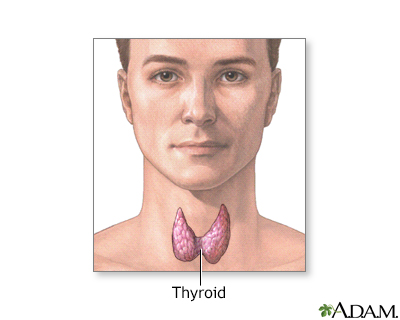You are getting ready for bed and as you wash your face, you feel a lump on your neck. At first, you just think it’s a knot in your muscles from a stressful day at work, or maybe your allergies are flared up. What you don’t know is that lump might be cancer growing on your thyroid gland and ignoring it will make treating that cancer more difficult.
Your thyroid is a gland located in your neck, right below the Adam’s Apple. This gland is critical because it regulates hormones that control your body temperature and your heart rate.
How can I tell if I have Thyroid Cancer?

Symptoms of thyroid cancer can be obvious or subtle. There are several ways you can screen yourself for concerning changes. Thyroid cancer can cause:
- A lump in your neck
- Changes in your voice
- Difficulty swallowing
- Throat and/or neck pain
- Swollen lymph nodes in your Neck
You may notice these symptoms as part of your daily routine.
During an routine checkup with your primary care provider, they will usually check your lymph nodes and thyroid. If they find a lump on your neck, the doctor may order an ultrasound, biopsy or blood test.
Is the lump on my thyroid cancerous?
The thyroid is know for having lumps develop on it and only rarely are they cancerous. These lumps are called nodules. They can be soft or firm.
You shouldn’t ignore these nodules but also shouldn’t panic since they aren’t usually cancerous or even cause symptoms. If a doctors exam and diagnostic testing reveals the lump on your thyroid isn’t cancerous, they will ask you to simply monitor the lump for changes. If the nodule starts to cause issues with breathing or eating, or is determined to be cancerous, your doctor will work with you on a treatment plan.
There are risks that may put you at a higher risk of cancer growing on your thyroid.
- Radiation exposure to your head or neck
- Female: Women have a higher risk of thyroid cancer
- Family history of thyroid cancer or other genetic factors

Is thyroid cancer survivable?
Like many types of cancer, early diagnosis gives you better chances of surviving.
Treatment plans are customized to you and beating your cancer. At a minimum, the section of thyroid where the cancer is growing is removed. Many times, the entire thyroid is removed.
When the thyroid is removed, you will have to take replacement hormones since the thyroid plays a critical role in daily activity.
If you have thyroid cancer, there is a good chance you can beat it. All but the most aggressive forms of this cancer have a nearly 100% survival rate if only the thyroid is affected. If the cancer spreads, which can happen, the survival rate goes down. Early detection is key.
Sources
Thyroid Cancer, Mayo Clinic
Thyroid Cancer Survival Rates, by Type and Stage, American Cancer Society
Thyroid Cancer Treatment (Adult), NIH National Cancer Institute


